
The Argentine Confederation was the last predecessor state of modern Argentina; its name is still one of the official names of the country according to the Argentine Constitution, Article 35. It was the name of the country from 1831 to 1852, when the provinces were organized as a confederation without a head of state. The governor of Buenos Aires Province managed foreign relations during this time. Under his rule, the Argentine Confederation resisted attacks by Brazil, Bolivia, Uruguay, France and the United Kingdom, as well as other Argentine factions during the Argentine Civil Wars.

Juan Bautista Alberdi was an Argentine political theorist and diplomat. Although he lived most of his life in exile in Montevideo, Uruguay and in Chile, he influenced the content of the Constitution of Argentina of 1853.

Juan Facundo Quiroga was an Argentine caudillo who supported federalism at the time when the country was still in formation.
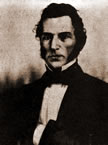
Valentín Alsina was an Argentine lawyer and politician.

Juan Galo Lavalle was an Argentine military and political figure.

The San Nicolás Agreement was a pact signed on May 31, 1852 and subscribed by all but one of the 14 provinces of the United Provinces of the River Plate. The treaty consisted of 19 articles, and its goal was to set the bases for the national organization of the young Argentine state. It also served as precedent to the sanction of the Argentine Constitution of 1853.
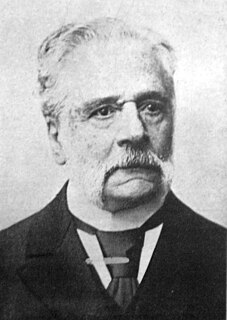
Bernardo de Irigoyen was an Argentine lawyer, diplomat and politician.
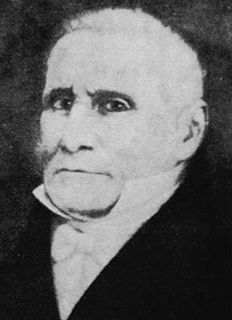
Feliciano Antonio Chiclana was an Argentine lawyer, soldier, and judge.
Sixto Casanovas, was an Argentine politician, provisional governor of Córdoba Province (1835).

The French blockade of the Río de la Plata was a two-year-long naval blockade imposed by France on the Argentine Confederation ruled by Juan Manuel de Rosas. It closed Buenos Aires to naval commerce. It was imposed in 1838 to support the Peru–Bolivian Confederation in the War of the Confederation, but continued after the end of the war. France did not land ground forces, but instead took advantage of the Uruguayan Civil War and the Argentine Civil Wars, supporting Fructuoso Rivera and Juan Lavalle against Manuel Oribe and Rosas.

Ángel Vicente "Chacho" Peñaloza was a military officer and provincial leader prominent in both the history of La Rioja province and the Argentine civil wars that preceded national unity.

The State of Buenos Aires was a secessionist republic resulting from the overthrow of the Argentine Confederation government in the Province of Buenos Aires on September 11, 1852. The State of Buenos Aires was never recognized by the Confederation or by foreign nations; it remained, however, nominally independent under its own government and constitution. Buenos Aires rejoined the Argentine Confederation after the former's victory at the Battle of Pavón in 1861.

Ángel Pacheco, was an Argentine military officer trained by José de San Martín who later became one of the top commanders in the Confederacy during the dictatorship of Juan Manuel de Rosas. He never lost a battle under his command.
The rise of the Argentine Republic was a process that took place in the first half of the 19th century in South America. The Republic has its origins in the Viceroyalty of the Río de la Plata, a colony of the Spanish Empire. The King of Spain appointed a viceroy to oversee the governance of the colony. The 1810 May Revolution deposed the viceregal representative and, along with the Argentine war of independence, started a process to replace the foreign monarchy with an indigenous republican state. All proposals to organize a local monarchy failed, and no local monarch was ever crowned.

The Desert Campaign (1833–1834) was a military campaign in Argentina led by Juan Manuel de Rosas against the indigenous people of the southern Pampas and northern Patagonia. The campaign was later followed by the Conquest of the Desert, which took place in the 1870s and 1880s.

José Nazario Benavídez was an Argentine soldier who rose to the rank of Brigadier General and played a leading role in the Argentine Civil Wars. He was Governor of San Juan Province, Argentina, for almost twenty years in the mid-nineteenth century. His lengthy political career during a period of great turbulence was due to the great respect in which he was held by enemies as well as friends. After leaving office he was imprisoned and then murdered by his guards.
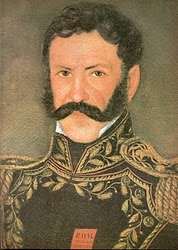
José Félix Esquivel y Aldao was an Argentine Dominican friar and soldier who became a General and then the undisputed Federist caudillo of Mendoza Province. His ability as a warrior and his cruelty became legendary. The largely fictionalized biography that Domingo Faustino Sarmiento wrote fed his legend. An effective ruler, he did much for his province, but was also one of the cruelest of the federalist leaders.
The Battle of Rodeo del Medio, fought in Mendoza Province, Argentina on 24 September 1841, was a battle between the Federalist army of Ángel Pacheco and the Unitarian army of Gregorio Aráoz de Lamadrid during the Argentine Civil Wars. It gave victory to the Federalists that would last for a decade.
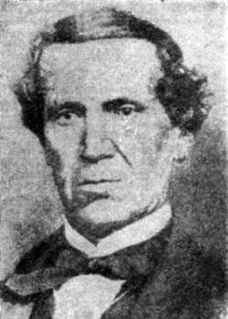
Manuel José Gómez Rufino was an Argentine politician who was governor of San Juan Province, Argentina between 1857 and 1858 and again between 1873 and 1874.
José Santos Ramírez was an Argentine soldier for a long time in the militia of Mendoza Province, and was involved on the Federalist side in several of the Argentine Civil Wars.
















